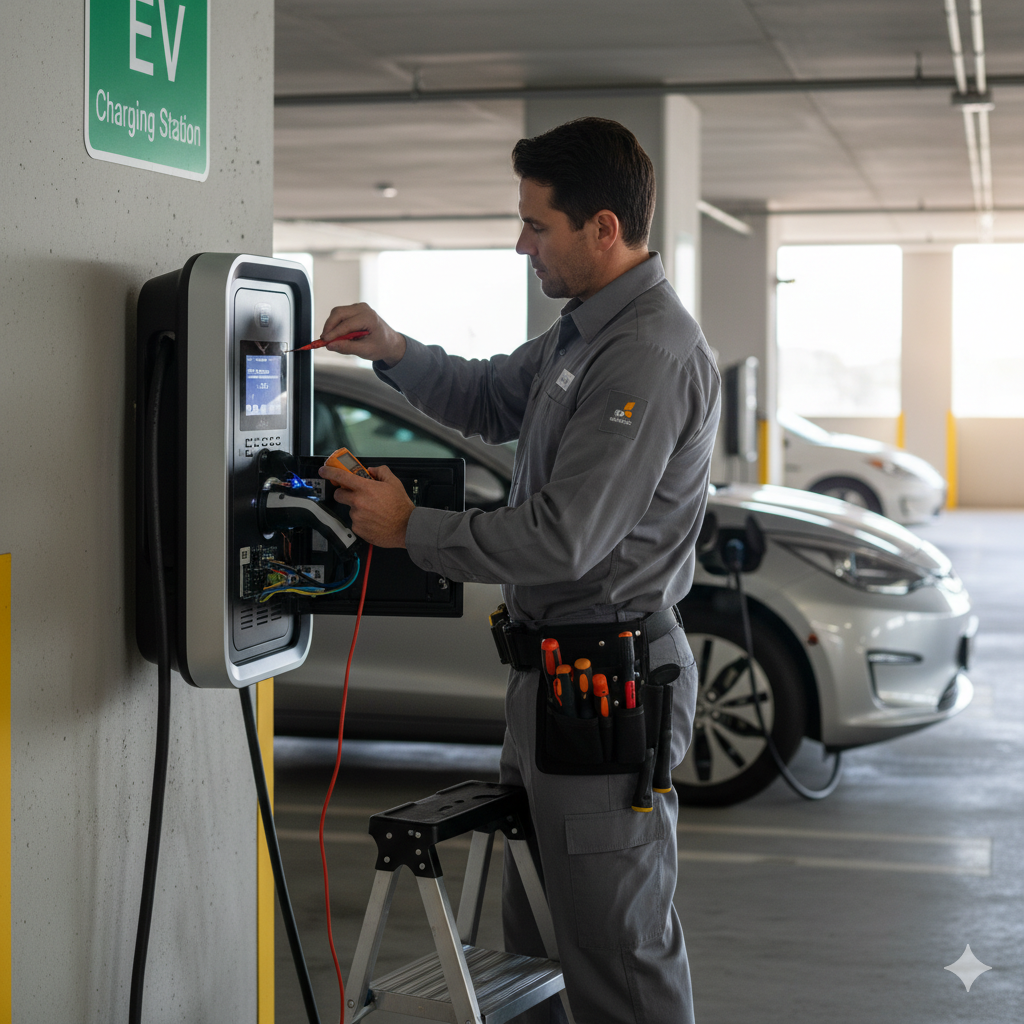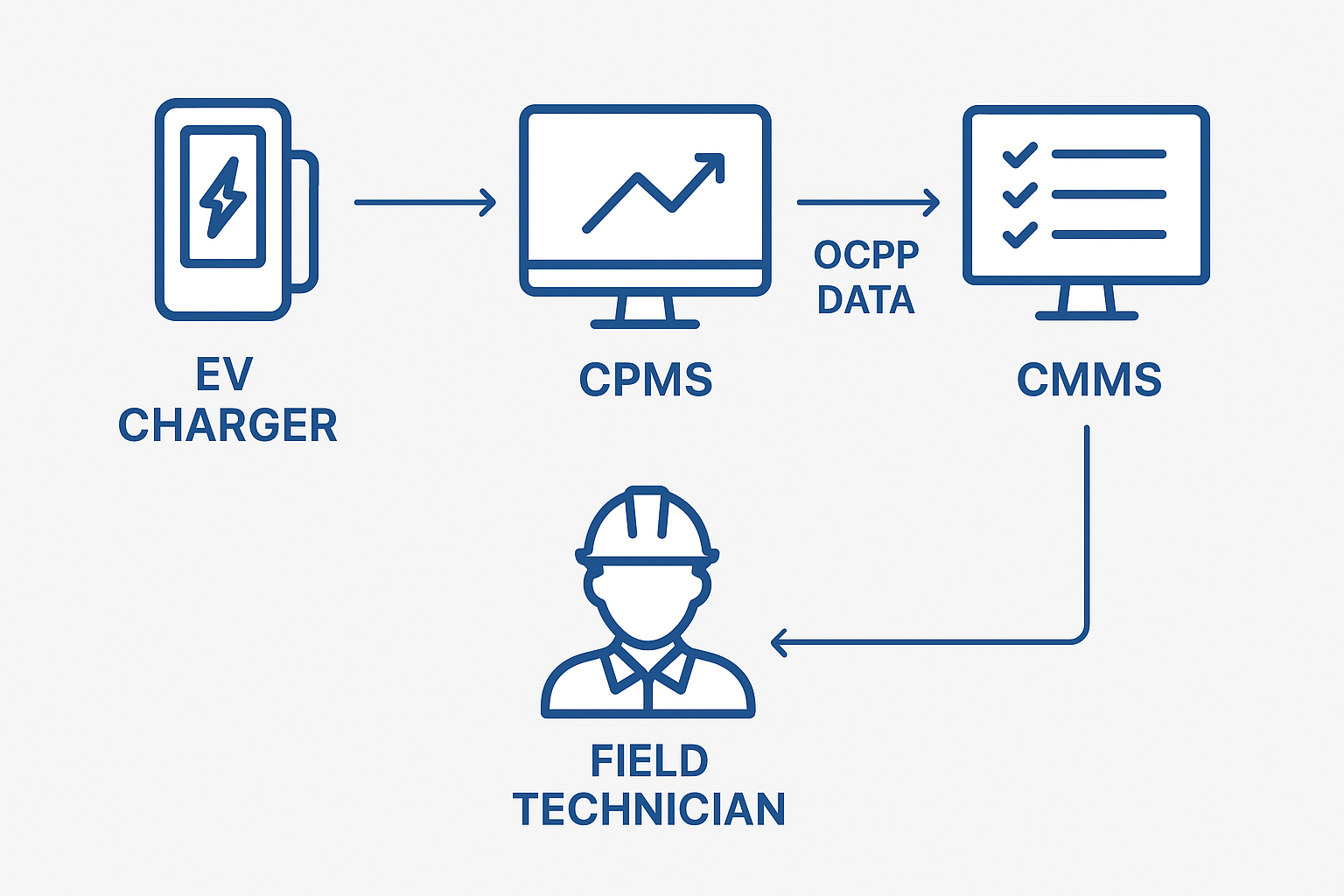How Smart Operators Close the Reliability Gap Beyond Their CPMS

The Hidden Layer Behind Real EV Charger Uptime
Every Charge Point Operator (CPO) today runs on a Charge Point Management System (CPMS). It’s the digital command center that manages charger visibility, user sessions, tariffs, and billing. Yet, even with the best CPMS in place, operators still face the same pain points: repeat faults, downtime blind spots, and fragmented maintenance workflows.
The reason is simple — CPMS' were never designed to close the reliability loop. Smart operators are now going beyond their CPMS and integrating Computerized Maintenance Management Systems (CMMS) like Energos.ai to achieve true, measurable uptime.
1. OCPP Enables Communication — Not Maintenance
The Open Charge Point Protocol (OCPP) is the global language connecting EV chargers and back-end systems. It allows platforms to:
- Monitor charger status (Available, In Use, Faulted, Offline)
- Start and stop sessions remotely
- Collect energy and meter data
- Receive fault notifications
But OCPP stops at communication. It doesn’t tell you why a fault occurred, what parts were replaced, or how to prevent it from happening again. It’s the difference between knowing something is wrong and knowing how to fix it — for good.
2. What a CPMS Is Built to Do
A CPMS is excellent for operations and business control, managing:
- Charger availability and uptime metrics
- Tariffs and billing
- User access and authentication
- Roaming and interoperability (OCPI, eMIP)
- Real-time dashboards and reporting
Some CPMS vendors now include basic asset lists or ticketing features, but these are surface-level — designed for monitoring, not reliability management. The CPMS’ primary goal is simple:
“Keep chargers visible, available, and billable.”
3. Where the CMMS Comes In
A CMMS manages the physical reliability of chargers and assets. It connects the dots between fault detection and verified resolution.
A robust CMMS handles:
- Work order creation and technician dispatch
- Preventive maintenance scheduling
- Spare parts, warranty, and vendor tracking
- AI-driven fault loop and MTTR/MTBF analysis
- Mobile-first workflows for field teams
Where CPMS stops at ticket creation, CMMS closes the loop — ensuring every fault is diagnosed, repaired, verified, and recorded for future insight.
4. Why Smart Operators Still Need a CMMS
Even CPOs with sophisticated in-house CPMS systems often discover:
- Technicians rely on messaging apps or spreadsheets for updates
- Spare parts and warranty data are tracked manually
- Recurring faults go unnoticed
- Root causes aren’t identified or analyzed
Without a CMMS, operations stay reactive.With one, they become predictive and structured — reducing cost, downtime, and human dependency.That’s why modern operators and service partners are adopting a CMMS platform like Energos.
5. OCPP + CMMS = Intelligent Reliability
By integrating OCPP directly into a CMMS, you create a charger-aware reliability platform.
This integration allows systems like Energos.ai to:
- Auto-generate work orders from real-time OCPP fault codes
- Link issues with technician history and part replacements
- Trigger remote resets or firmware updates when possible
- Predict failures using AI models trained on fault patterns
It transforms maintenance from reactive firefighting into proactive uptime assurance.
6. CPMS and CMMS: Complementary, Not Competing
Think of your tech stack like this:

- CPMS is the brain — managing sessions, payments, and user interactions.
- CMMS is the nervous system — converting data into corrective action.
- OCPP is the signal that connects both layers.
Together, they form a complete reliability ecosystem that drives higher uptime, lower OPEX, and better driver experience.
7. The Energos.ai Reliability Layer
At Energos, we don’t replace your CPMS — we enhance it. Our CMMS integrates seamlessly with leading CPMS platforms and charger networks via OCPP or APIs, adding the missing reliability layer operators need.
With Energos.ai, you can:
- Detect and resolve faults faster
- Manage technicians and vendors from one unified dashboard
- Track parts, SLAs, and maintenance costs
- Predict failures before they occur
- Achieve measurable, network-wide reliability gains
Energos.ai is how smart operators close the gap between visibility and reliability.
8. Conclusion: The Future of EV Uptime
As the EV industry scales, the difference between operational visibility and operational excellence will define the leaders.
Supporting OCPP or ticketing isn’t enough — reliability demands a system that thinks, learns, and acts.
The future belongs to operators who bridge CPMS and CMMS into one ecosystem. That’s how smart operators close the reliability gap — and how the EV charging experience finally becomes trustworthy at scale.
Topics:
Operations & Maintenance
Energy & Utilities
Start Your Free Journey to Smarter Maintenance Today!
Take control of your maintenance operations—streamline, schedule, and track all your tasks with powerful maintenance platform. Get started today and boost your team’s efficiency!

